3. Keeping It Safe
Koizumi-san, when you heard I thought it would be good if Hatena worked on it, what did you think?
I was really surprised. Until then we had planned on doing it all in-house. Besides, they're like a championship team from Koshien Stadium. (Koshien Stadium is where the Japanese National High School Baseball Tournament finals are held each year)
So how was your first game against - your first meeting with - these champs?
First we gave them a simple presentation. At first we sat at a big table across from each other, and began explaining using presentation software, but halfway through it got complicated (laughs), so I asked if I could go over to their side of the table, took the Nintendo DS, and sat down between Kondo-san and Ninomiya-san.
Because the quickest way to understand is to look at the actual product. (laughs)
I was like, "This goes like this, and when this happens, bingo!" And after they'd looked it over, I explained what we had in mind for the network. Then they hit us with a barrage of questions, so I knew we should ask them to work on it. (laughs)
Koshien is the ballpark of champions. (laughs)
Kondo-san, what did you think when someone from Nintendo suddenly sat down next to you?
At Hatena we hardly ever use presentation software. Our motto is "Show them the real thing!" so it felt right to me. I thought, "Oh, they're like us!" (laughs)
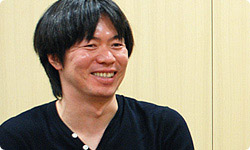
In that area they're exactly like us. First they make a test model, something that actually works to a certain degree, look at it together, and then say, "No, not like that..." or "No, not like this...".
When Koizumi-san sat down next to me and started energetically saying, "This is like this, and when you do this, see, isn't that cool?" I thought he was a lot like Kondo-san. (laughs)
Kondo-san is known for exclaiming, "I just hit on something amazing! Look!" (laughs) Then he shows us an idea he whipped up on his notebook computer. Adding the specific features comes later. Koizumi-san was a lot like that.
The same. (laughs)
Yes, I thought so.
Shimizu-san, I don't act like that, do I?
Well, maybe once every three days or so.
Kondo-san, when you first heard about this software, what did you think?
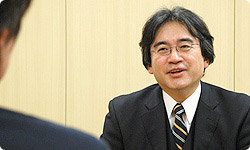
Be honest! (laughs)
To tell the truth, I wondered what in the world it was. I wondered if you could really sell it as a game.
You wondered what these two had in mind for this...whatever-it-was. (laughs)
(laughs) At the time, we didn't know much about the Nintendo DSi, so we thought it would be sold normally as packaged software. We wondered what kind of people would buy it.
Besides, I hadn't drawn flick book animation since junior high school, so software allowing me to do so wasn't exactly enticing, but when I saw how it worked, it made quite an impression on me. I felt like saying, "Let me try it!" Then, when I heard that it would be available for free download onto the new Nintendo DSi, I understood.
Koizumi-san, once they had the concept, how did you introduce the idea of the bulletin board?
I envisioned a bulletin board to which users could submit lots of their own creations. I told them that we wanted them to make the board a gathering point for users - a community - where the users themselves would determine the rules, instead of us trying to check every single one of them.
I suggested a plus-minus point system so everyone could score each other's creations - a system by which more and more people would view the good ones and ignore the ones that weren't so great - but they had an even better idea.
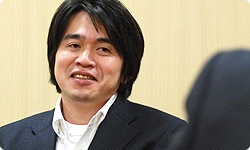
Kondo-san, what kind of idea was it?
When I first heard about it, I imagined something that would not have to be monitored 24 hours a day, something that wouldn't make users wait for approval before their creations could be posted.
If it did need to be monitored that much, it wouldn't feel live, and the more popular it became, the harder it would be for those facilitating the site.
Right. If users knew someone was watching, they might feel intimidated. And we got rid of the minus points.
Why?
Well, the Nintendo DSi is supposed to be fun. A minus button for negative evaluations on the screen would detract from that. Besides, if you gave someone a minus, you would need to give them some kind of reason as feedback, and if you submitted something and got three minuses, you wouldn't like it very much. Then, even if you couldn't be certain, you'd start wondering who gave you a minus and consider giving one in return. It would be a vicious circle.
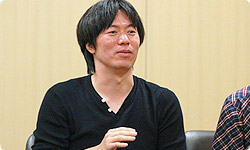
It could get out of control. But if evaluations have to be positive, people might submit inappropriate material.
So we adopted a "reporting" system. Speaking from Hatena's past experience, suppose one million people award others a star as a positive evaluation. About one in ten thousand would report works that they thought weren't appropriate. We thought it would be more enjoyable if we set it up so that only certain people were able to report and as many people as possible were only able to praise.
Who are the "certain people"?
Web users. Once a certain period of time has passed, only works that haven't been reported on, even once, can be displayed on a Nintendo DSi.
In other words, when a user submits his or her animation, it first appears openly on the Internet for viewing on personal computers and the like. If Hatena's users see it and feel like there's a problem within a relatively short period of time, they will report it to Hatena as inappropriate.
Right. It's designed so that if there's even one report, it can't be sent to a Nintendo DSi. But once a certain amount of time has passed, it's deemed acceptable for a broader audience and can be viewed on a Nintendo DSi. Hatena has lots of users who might report to us, so I wanted to borrow their help in realising a safety filter.
Your previous experience really came in handy.
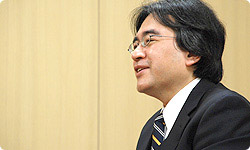
Not just our experience, but our users as well. People who only use the Nintendo DSi might feel like something is a little amiss since none of the posts are inappropriate.
I suppose so. They might think that nothing inappropriate gets posted because someone at Nintendo is checking the posts 24 hours a day.
Probably. But the truth is, since Hatena users are cooperating behind the scenes, users can feel reassured. And we at Hatena want to do our best as well.
Working together with such experienced individuals such as yourselves allows the addition of features that we would otherwise be incapable of. You're really helping us out.